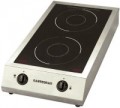Burner controls
Controls that are directly responsible for adjusting the power of the burners. At the same time, other control elements can be provided in the design. For example, rotary knobs are often combined
with buttons, to which additional functions are designated.
—
Rotary knobs. The traditional, most common option, found in hobs of all types — both gas and
electric — and price categories. Rotary knobs are quite convenient and functional while being simple in design and inexpensive.
—
Pop out knobs. A variation on the rotary knobs described above, in which the control knobs can be recessed into the control panel. The specific design may be different: in some models, the handle is recessed during operation; in others, it remains recessed until the corresponding burner is in use and pops out from the panel during operation. This design gives the hob a neat appearance, reduces the number of places where dirt can accumulate, and makes the front panel easier to clean. Unlike rotary knobs, pop out knobs are mainly used in electrical models.
—
Touch controls. Touch controls are found only in electric hobs. This option has several advantages. First, the touch controls look neat and have no protruding parts, making them easy to clean. Secondly, the control is carried out with light touches and req
...uires minimal effort. Thirdly, touch controls give the stove a stylish and technological appearance. On the other hand, such stoves are quite expensive and may be inconvenient for some users who are accustomed to traditional rotary knobs. Therefore, relatively few touch control models are produced. Usually, it is compact hobs for 1 – 2 burners without an oven, where rotary knobs would not be very appropriate.
— Slider. A kind of touch control represented by sensitive tracks. To adjust the heating intensity of the burners or quickly access other settings of the hob, slide your finger along the corresponding touch scale to the selected value. The convenience of slider control also lies in the fact that you can immediately set the required heating power by clicking on a certain area of the scale.
— Push-buttons. Control, carried out exclusively with the help of buttons, is used very rarely in modern stoves. Most models with such controls are compact portable stoves for one or two burners: it is not always convenient to equip such devices with rotary knobs, but the buttons fit well into the design. They are also cheaper than touch controls. On the other hand, the price difference is not so great, and the buttons are somewhat less convenient to use and clean — mainly for this reason they are noticeably less common.Burner power
Rated burner power. This parameter allows you to estimate how much electricity the burner will spend when operating at maximum heating intensity. At the same time, the heat transfer power of different burners can be different, and the actual heating efficiency will also greatly depend on the specs of the dishes. As a result, it hardly makes sense to evaluate the operating capabilities of the stove by the power of the burners. It is quite possible to proceed from the fact that the burner will be enough for a dish of the same diameter.
Automatic switch-off
The type of automatic switch-off provided in the design of the stove.
Auto-off can be provided
for the hob(hob),
for the oven, or for both at once, regardless of whether the hob and oven are gas or electric. This function is implemented through a timer, after which the device turns off.
Connected load
The connected load of the stove is the maximum electrical power consumed during operation. This parameter is indicated only for models that are equipped with at least one electric heater — burner (burners), oven or grill. It is the burners that are the highest consumption in terms of energy consumption; Features such as auto-ignition or oven lighting require little energy, a ordinary socket is enough for them.
First of all, the requirements for the power grid depend on this indicator: it must be able to provide such power without overload. It is worth noting that for household sockets the power limit is about 3 – 3.5 kW; with more power, you need to connect the stove to a 230 V network according to special rules. An alternative is a three-phase 400 V mains: most modern stoves with electric heaters allow connection to both 230 V and 400 V.

